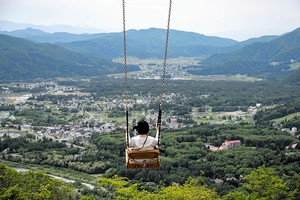By LISA VOGT/ Special to Asahi Weekly
January 23, 2024 at 07:30 JST
Does it really rain 366 days a year on Yakushima island, the place that inspired Hayao Miyazaki’s 1997 animated film “Princess Mononoke”?
Having visited the island several times, I was about to agree until my last visit, during which I was blessed with sunshine for three days straight.
The fourth, however, was a downpour and all flights out of the island were canceled.
Talk about a mess! There was a mass scramble to secure accommodations and a way to get to a hotel with flight loads of stranded passengers competing for a piece of a small pie. It was quite the experience.
Yakushima’s most iconic feature is undoubtedly its ancient 1,000-year-old “Yakusugi” and 2,000-year-old “Jomonsugi” cedar trees. Amid these primeval woodlands, one can’t help but contemplate the profound sense of time and history that this island embodies.
Every time I go to the forests on the island, I am humbled by the majesty of nature’s resilience. I find it inconceivable that logging continued there until the 1970s.
Yakushima’s biodiversity flourishes within its verdant landscape, providing a haven for the unique flora and fauna, including the endemic Yakushima macaque and Yaku deer.
These species can frequently be observed foraging along roadsides and hiking trails. They don’t seem to mind people pointing their smartphones toward them and snapping away as they groom each other.
What makes the island extraordinary is its vertical distribution of vegetation. What’s that, you ask? Yakushima is for the most part round, has an area of about 504 square kilometers and a mountain range more than 1,800 meters high in the center.
The range of ecosystems from its coast to its peak at Mount Miyanoura mimics those of the entire Japanese archipelago.
Atop the mountain, with snow in the winter, is the same as in Hokkaido, with grassland that consists of dwarf bamboo.
A little lower from around 1,600 meters, it becomes a shrub zone, then mixed conifer (cedar). As you gradually move down, you see mixed needleleaf and broadleaf forests.
At under 800 meters, closer to the ocean, is the laurel forest zone with banyan trees and Japanese red oak. So, a wide climatic range--from subarctic to subtropical climates--exists on one small island.
Driving through the Seibu Rindo Forest Path in the western part of the island that goes through 20 km of a forest untouched by humans and which is part of the World Heritage Site, I felt a presence in the car next to me.
Was it some mystical being from Mononoke’s enchanted world?
I think so.
* * *
This article by Lisa Vogt, a Washington-born and Tokyo-based photographer, originally appeared in the Nov. 19 issue of Asahi Weekly. It is part of the series "Lisa’s UNESCO World Heritage Sites in Japan," which depicts various parts of the country through the perspective of the author, a professor at Aoyama Gakuin University.




















A peek through the music industry’s curtain at the producers who harnessed social media to help their idols go global.
A series based on diplomatic documents declassified by Japan’s Foreign Ministry
Here is a collection of first-hand accounts by “hibakusha” atomic bomb survivors.
Cooking experts, chefs and others involved in the field of food introduce their special recipes intertwined with their paths in life.
A series about Japanese-Americans and their memories of World War II